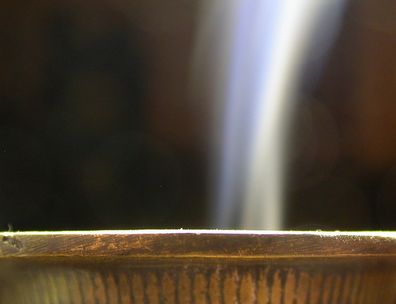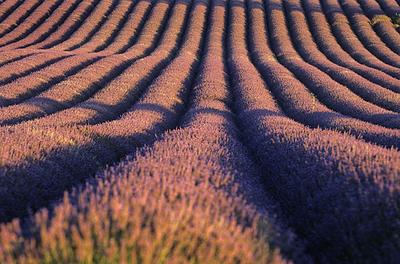Encens et Lavande by Serge Lutens {Perfume Review & Musings}

Encens et Lavande (Incense and Lavender) was introduced in 1996 in the collection "Les Eaux Anciennes" (Ancient Eaus) part of the exclusive, non-export line of perfumes by - rather, one should say in a standard fashion where the visionary from Marrakech is concerned, dreamt by - Serge Lutens. Like most of the fragrances from Palais Royal-Shiseido it was created in collaboration with perfumer Christopher Sheldrake. The official description for the scent is terse, listing four main notes: incense, lavender, vegetal amber, and clary sage. This initial description suits to some extent the austere character of a scent whose only concession to worldly pleasures is to smell elegant.......

The perfume starts with a fresh outburst of cologne made from an ancient recipe, where the accents of a dry (as in non-sweet) lavender mingle with citruses and rosemary creating a flash of whiteness, paleness, and corporeal purity transiently evoking a picture-perfect moment à la toilette in one's bathroom. It is a short moment of purification, physical or mental, prior to entering the space of the sacred whose form is as of yet, indefinite. Soon the pungent aromas of dry herbs enter and the lavender now feels dry in a more literal fashion, as in sun-dried. The nuances are slightly dusty and mineral, evoking lavender that was harvested and laid to dry on the ground, perhaps by the side of a Roman-style medieval monastery whose lavander field is one of its resources. Lavender like incense can both be associated with religious connotations when one is familiar with the Provence region. Both have moreover cleansing and purifying properties.
The heart is warm, amberey and slightly sweet, but never so much so as to let go completely of the coolness and transparent airiness of the lavender. We soon see this cold facet enhanced by the smoky wet chilliness of incense.
The term "incense" can refer to different things. It is often a substitutive term for Frankincense. It can also refer in a more encompassing manner to the two most noble and sought-after incenses of the Antiquity, Frankincense and Myrrh as seems to be the case here. More generally, it can designate a number of raw materials that are used to make incense in different cultural traditions. For example and by contrast, Bois D'Arménie by Guerlain conjures up Buddhist temples and an Eastern tradition of incense-making with its note of benzoin from Laos. With Encens et Lavande, we remain in the realm of Europe as inclusive of an Arabian and African tradition and of the history of a quest for precious aromatic materials that were once considered to be as valuable as gold if not more so.
As the clean fresh notes of lavender recede and become more discreet, a darker accord emerge that feels retrospectively like the passage from broad daylight and a solar instant filled with a profusion of enchanting noisy crickets to the contrasting somber and cool interior of a church. The stones seem to breathe a perfume that then smells tarry, amberey, almost black but not quite, and more solemn. The contemplative accord of incense smells mysteriously - through some centuries-old association - of humid church stones. Myrrh immediately evokes to the nose, the worn-out humid flagstone of an empty church resounding silently with the echo of lost steps and covering the invisible presence underneath of a sepulchre.
The perfume in the bottom note develops a slightly burnt smoky and tarry note of immortelle, which together with the vegetal amber transform Encens et Lavande into an elegant dry and warm skin scent. It feels even slightly bitumous. Despite the Antique motifs, the structure of the perfume feels uncluttered and modern. If some elements of the religious are present in this composition, they feel ultimately reined in, tamed by a sense of urbanity as the scent ends up feeling mostly subdued. It is not the scent of an excessive human being who wants to depart for the desert, of an hermit (contrary to the perfume called Hermit in the Mugler coffret). It is the incense rendition of a civilized polite person, an urban-dweller, who is more intense than average and like Serge Lutens himself, occasionally likes to interrupt a promenade to step into empty churches in Paris to remind himself of the mystical dimension of the unseen and to inhale his favorite aromas of beeswax and incense embers.
Next, we will review Belle En Rykiel, which also offers a main lavender and incense accord.
Photos by Michael and Saracino










Lovely review as always.
This starts very cool and then warms up for me. Love the drydown! It is muystical and serene.
One of your loveliest reviews, ma belle...
This was the first exclusive SL I ever smelled, 10 years ago, in Paris.
I loved it immediately, and still do.
And I concur, it feels much more European than Eastern.
Helg and Chaya have already said it - yours is a truly lovely review, evocative as the fragrance itself. What appeals to me most about it is the pairing of chilly and warm (think of La Myrrhe) and its effortless elegance. Thanks for writing about this gem.
Helg and Chaya have already said it - yours is a truly lovely review, evocative as the fragrance itself. What appeals to me most about it is the pairing of chilly and warm (think of La Myrrhe) and its effortless elegance. Thanks for writing about this gem.
Thank you Helg for your kind comment. It certainly plays with our mystical chords.
Chaya,
Thank you. Evocative fragrances are easier to review than the flatter types.
For a Middle Eastern incense fragrance I think of Amouage Gold for Men and for a South East Asian incense one, I think of Bois D'Arménie. Kyoto for the Far East obviously although I would need to re-sniff it to have more precise impressions of it.
Thank you Dusan. You're welcome. Yes, La Myrrhe has that same coldness and dampness.